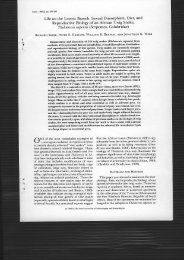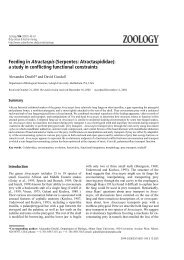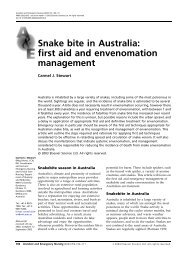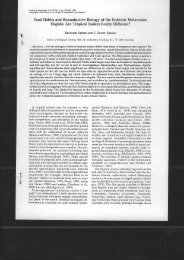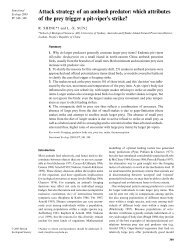Introduction - Kingsnake.com
Introduction - Kingsnake.com
Introduction - Kingsnake.com
Create successful ePaper yourself
Turn your PDF publications into a flip-book with our unique Google optimized e-Paper software.
Clinical Management of Snakebite in Papua New Guinea Chapter 1<br />
australis) bites may also produce significant local pain and oedema. Local pain and swelling<br />
caused by snakebite should not be confused with the pain and swelling that can be associated<br />
with ischemic injury due to prolonged tourniquet use.<br />
Non-specific Indications of Envenomation<br />
A number of non-specific features have been reported consistently in patients with snakebite<br />
envenomation. Campbell & Young (1961), and Campbell (1964; 1966; 1967a; 1967c; 1969a)<br />
reported that headache often followed envenomation, and headache has been universally<br />
reported in virtually all published accounts of snakebite in PNG. Headaches are reported to<br />
have last from a few hours to several days. Hudson & Pomat (1988), Lalloo et al (1996) and<br />
Warrell et al (1996) report headache as <strong>com</strong>mon following bites by death adders (Acanthophis<br />
spp.) and small-eyed snakes (Micropechis ikaheka). Herpetologist Ken Slater had persistent<br />
severe headache for two days after a bite from Micropechis ikaheka. Lalloo et al (1994) noted<br />
headache in 2 of 9 patients with confirmed Papuan blacksnake (Pseudechis papuanus) bite,<br />
and Lalloo et al (1995a) reported headache in 54.5% of positively identified Papuan taipan<br />
(Oxyuranus scutellatus canni) victims. In an analysis of referral letters written by rural health<br />
workers during the early 1990’s, Trevett et al (1995) found that headache was reported in<br />
37% of patients at the health centre, and in 58% of the same patients on admission to PMGH.<br />
Headache was reported in 51.9% of 564 patients bitten by snakes in Mekeo (Williams et al<br />
2003). Headache was a documented non-specific symptom in 38 (63.3%) of 60 fatal<br />
snakebites treated at PMGH between 1992 and 2001 (McGain et al, 2004).<br />
Vomiting and abdominal pain or tenderness typically occurs in unison. Campbell & Young<br />
(1961) observed concurrent vomiting and abdominal pain in 3 patients, while another 3<br />
patients had vomiting without abdominal pain. One patient with severe abdominal pain and<br />
vomiting in conjunction with abdominal tenderness was mistakenly diagnosed with acute<br />
appendicitis. Vomiting was reported in 42% and abdominal pain in 34.6% of patients<br />
described in Campbell (1964). Vomiting was a typical non-specific indication in patients of<br />
death adder (Acanthophis spp.) bites reported by Campbell (1966), and was also recorded in<br />
three patients with presumed Papuan taipan (Oxyuranus scutellatus canni) bite (Campbell,<br />
1967a). In the series of 13 bites dubiously ascribed to Papuan blacksnake (Pseudechis<br />
papuanus) envenomation, but most probably really having been caused by Papuan taipans<br />
(Oxyuranus scutellatus canni), 8 patients had early vomiting and 4 had severe abdominal pain<br />
(Campbell, 1967c). Vomiting after bites from the small-eyed snake (Micropechis ikaheka) has<br />
been reported by Blasco & Hornabrook (1972) and Warrell et al (1996). Abdominal pain was<br />
reported in 2 of the 6 patients reported in Warrell et al (1996). Hudson & Pomat (1988)<br />
reported abdominal pain in 56% and vomiting in 25% of 64 envenomed patients treated for<br />
either death adder (Acanthophis spp.) or small-eyed snake (Micropechis ikaheka) bites in<br />
Madang during the 1980’s.<br />
Of 9 patients with confirmed Papuan blacksnake (Pseudechis papuanus) envenomation, 2<br />
vomited and 5 had abdominal pain (Lalloo et al, 1994). In a large series of Papuan taipan<br />
(Oxyuranus scutellatus canni) bite victims, 64.4% vomited and 59.8% had abdominal pain. In<br />
the analysis of referral letters conducted by Trevett et al (1994a), 38% had abdominal pain<br />
and 30% had vomited at the health centre; on admission to PMGH 58% had abdominal pain<br />
and 62% had reported vomiting. Williams & Bal (2003) reported vomiting in 4 of 9 patients<br />
with likely Papuan taipan (Oxyuranus scutellatus canni) envenomation and 3 of these 4<br />
patients had concurrent abdominal pain. Williams et al (2003) reports abdominal pain in<br />
48.9% of 564 patients bitten by snakes in Mekeo; however, nausea or vomiting was only<br />
reported for 6.2%. Abdominal pain was documented in 48 (80%), and vomiting in 40 (66%)<br />
of the 60 fatal snakebites discussed by McGain et al (2004).<br />
- 1.17 -




